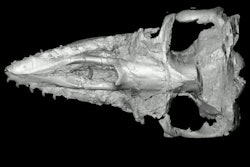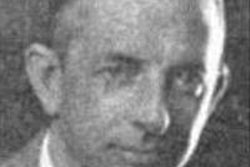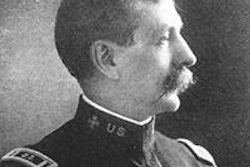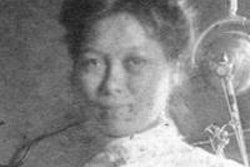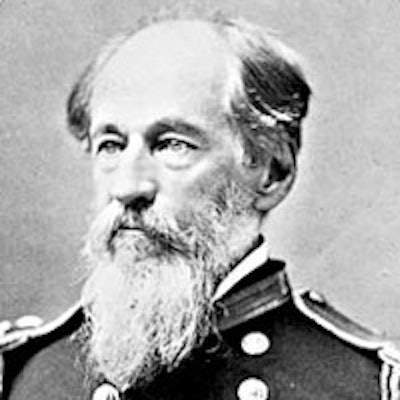
In 1849, with the ship St. Mary's, part of the U.S. Navy's Pacific Squadron, lying at anchor at the port of Callao, Peru, Lt. Fabius Stanly suffered "acutely from 'neuralgia' in the face."1 He thought that removing a tooth would alleviate the pain in his face and temple. After consulting with the ship's surgeon, who agreed the experimental extraction might work but didn't have the necessary instrumentation, Stanly was told to try the surgeon aboard the Ohio, the flagship of the squadron. The surgeon there didn't have the right tool either and advised Stanly to go "on shore and have the tooth extracted [by a dentist]."2
Upon returning to the ship with the "tooth in his pocket," he was advised that the ship's commander, Zachariah F. Johnston, felt that Stanly had gone on shore without permission. He immediately called on the commander and "explained the cause and manner of his absence."3 According to Stanly, Johnston took "no exception to my explanation and he supposed it was entirely satisfactory."4
As far as Stanly was concerned the incident had been forgotten, and Commander Johnston showed both hospitality and friendship toward him as the ship sailed north. Commander Johnston frequently invited Stanly to his quarters where the two "enjoyed refreshments."5
Two months after the incident, St. Mary's sailed into the Port of San Francisco. Within hours of his arrival, Stanly was "put under arrest and to his utter amazement" he discovered it was because of a report made by Commander Johnston to Commodore Thomas ap Catesby Jones about the toothache incident. The Johnston report was, in Stanly's words, "detestable, low, and [a] degrading offence [against him and a] falsehood."6
Stanly claimed Johnston was working in concert with Jones to "oppress and injure" him. He was put on trial, and Stanly believed "every effort was made to convict him," but he was acquitted.
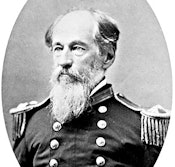 Lt. Fabius Stanly.
Lt. Fabius Stanly.
Shortly thereafter, Stanly's request to go-ashore on personal business was approved, provided he returned the same day. He missed the "Sunset boat," forcing him to stay in San Francisco overnight and return the next morning on the 7 a.m. boat. He claimed he was confused by the "multiplicity of new roads in San Francisco" and got lost "in a walk to a village, where the fatigue, the lateness of the hour (the consequence of getting lost), and the impossibility of getting horses" prevented him from obeying the "Sunset order."
His commanding officer requested he put his "reasons or excuses" in writing, which he refused to do. This refusal resulted in a court-martial overseen by Jones' good friend and ally Commander Johnston; Stanly was found guilty of disobedience of orders and conduct unbecoming of an officer and a gentleman. He was sentenced to a public reprimand by Commodore Jones and his Pacific Squadron service was extended by two years.
In the public reprimand, Jones accused Stanly of twisting facts with "a parity of false reasoning and vain boasting [and] evincing a recklessness of disposition or inexcusable ignorance of his obligations to his country and to his superior in command." Stanly appealed both the guilty verdict and the reprimand to the secretary of the Navy. He alleged that Jones' reprimand "degraded his duty" by an expansive and unwarranted "caustic criticism" of him not specified under the court-martial sentence.7
Stanly believed that his outspoken criticism of several incidents involving Commodore Jones led to his persecution. When Jones was ordered to take command of the Pacific Squadron in 1848, he had been permitted to bring with him his slave, Griffin Dobson. The department "normally did not provide additional pay for servants," but Jones had been injured during the War of 1812 and "did not have full use of [an] arm."8
Several years earlier, the Navy allowed the "negro slave" to be "rated as a seaman," thus permitting him to be paid.9 The unusual arrangement provided that Dobson's seaman's pay went to Jones, who could "pocket any funds not expended on him [Dobson]."10 During the voyage, Jones, who was financially strapped and under pressure from antislavery elements within the squadron, offered to sell Dobson. Jones sold Dobson for $400 to several "crewmen and high-ranking officers of antislavery sentiment" who pooled their funds.
They, in turn, freed Dobson, who proceeded "to the [California] gold fields to seek his fortune ... and raise money to buy the freedom of his wife and [five] children," all of whom were then enslaved at Jones' Virginia plantation.11 Three years later, Dobson was able to purchase their freedom for $1,200.12
According to Stanly, then serving on the commodore's flagship Ohio, he expressed his "opinion of the impropriety of such conduct." The criticism incurred the wrath of Jones, who immediately ordered him to serve on the Warren. An incensed Jones told Stanly that the Warren would be his "prison ship." Furthermore, "from that time he [Jones] set his panders to work to find causes of accusation against me," Stanley claimed.13
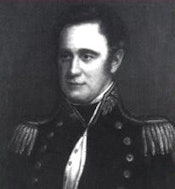 Commodore Thomas ap Catesby Jones.
Commodore Thomas ap Catesby Jones.
Another incident that enraged Stanly involved three other junior officers -- Lts. Craven, Marchand, and Green -- who had sought permission to go-ashore and travel to the California gold fields. Jones issued an order forbidding any watch officer from leaving the ship. He then wrote a letter to the Secretary of the Navy suggesting the trio were "tainted by gold fever."
Somehow the letter became public and was published in an East Coast newspaper. The three officers were enraged, alleging that the order infringed on their honor and that Jones' letter had publicly maligned their reputation and honor. The trio filed a formal complaint against Jones.14
Shortly before this incident, Jones himself had gone to the gold fields and purchased 1,808 troy ounces of gold, which could be purchased cheaply because of its abundance in California. The gold was purchased in large part using government funds, with some contributions from Jones and willing ship officers. The gold was then transported back to the East Coast and sold at a profit. Jones then replaced the government funds; he made a profit of $8,000. No profit was paid to the government for the use of its funds.15 Stanly alleged publicly that the scheme was a gross impropriety, again bringing the wrath of the commodore upon him.
In an effort to curb desertions to the gold fields, Jones had escalated the use of military discipline. Stanly described one incident that he found offensive, in which a merchant seaman (not a Navy sailor) impressed aboard the St. Mary's "grumbled as he went to obey an order." Commander Johnston had the man "stripped, lashed up to the hammock rail and down to the grating, and flogged with twelve lashes on his bare back, and without allowing the man one word in explanation or defense." When the man alleged that he was "flogged unjustly," Johnston had him "confined in double-irons." Stanly believed the man, not under military law, had been "tyrannically oppressed."16
After his "toothache" court-martial and subsequent court-martial for missing the return boat, Stanly filed a grievance with the secretary of the Navy. This, along with the grievances filed by Lts. Craven, Marchand, and Green, apparently caught the secretary's attention.
Navy Secretary William Graham was from North Carolina, as was Stanly and Stanly's brother Edward, then a sitting congressman.17 Stanly's father, John, had also served in the House of Representatives. Jones was ordered to vacate his command and return to Washington, DC. Upon his return, he was court-martialed and charged with fraud against the U.S. for using government funds to purchase gold; attempted fraud by finagling accounting to disguise the use of the funds; and scandalous conduct for "falsely, scandalously, and maliciously" accusing that Lts. Green, Marchand, and Craven had been "tainted by the maddening effect of gold mania" and thereby staining their records and "insulting their professional honor."18 Additionally, he was charged with neglect of duty and, lastly, oppression against Stanly.
The verdict was a mixed bag but did cite that Jones had conducted himself with "scandalous conduct" against Green, Marchand, and Craven. He was also convicted of "oppressing Lieutenant Stanley."19 The military court suspended him from further naval service for five years -- "the first two and a half without pay."20 Two years later, President Millard Fillmore remitted the remainder of Jones' sentence and he was relisted for a command -- something he never got. Jones died in 1858 at the age of 67.
As for the practice of flogging, in 1851 Congress outlawed it as a form of military discipline, due in large part to the publication of Herman Melville's White Jacket, which criticized the practice. A year later, Melville published Moby Dick. Most scholars believe both the "Commodore" in White Jacket and Captain Ahab were patterned after Jones. Melville, a whaling ship deserter, had been arrested by Jones and impressed as a sailor aboard Jones' flagship.21
It was there that Melville learned of an incident 27 years earlier, in which then Captain Jones' ship, the Peacock, had been rammed and severely damaged by a whale, which became the fictitious white whale in Moby Dick.22
Shortly after Jones' conviction, Stanly challenged Jones' co-conspirator, Commander Johnston, to a duel. Initially, Johnston seemed to agree to the duel, but he then withdrew his consent. Thereupon Stanly and his confederates posted at a hotel "a card or instrument in writing" accusing Johnston of being a "coward."23 The posted card in part accused Johnston of being "a vulgar associate with dissipated habits," a street brawler, and a "boaster ... devoid of the first principals of military honor."24 One of Stanly's confederates, Captain A. M. Dupereau actually threatened to "cut off Commander Johnston's ears."25
Stanly was then, once again, court-martialed. This time Stanly was accused of violating a naval regulation that forbade officers from "publishing or causing to be published, in newspapers, handbills, or otherwise, any disrespectful or offensive matter relative to transactions of a private nature between officers."26
Stanley was convicted and dismissed from the Navy. However, President Fillmore intervened and granted executive clemency to Stanly; he "mitigated" the sentence to "a suspension from service and pay for the term of twelve months."27 Stanly retired from the Navy in 1874, having achieved the rank of rear admiral after serving for 41 years. He died in 1882 at the age of 67.28
History does not record if the tooth extracted from Stanly in his experimental attempt to alleviate his facial neuralgia ever worked.
Daniel Demers is a semiretired businessman whose hobby is researching and writing about 19th and 20th century historical events and personalities. He holds a bachelor's degree in history from George Washington University and a master's degree in business from Chapman University. You can review his other published works at www.danieldemers.com.
References
- Court-Martial -- Fabius Stanly, Ex. Doc. No. 69, 32 Congress, 2nd Session, House of Representatives, 1853, 57.
- Ibid, 57, 61.
- Ibid, 57.
- Ibid, 57.
- Ibid, 56.
- Ibid, 57.
- Fabius Stanly letter to Secretary of the Navy, March 31, 1849. NARA: RG 45: Naval Records Collection and Library, Entry 464 Subject File 1775-1910, File NO-Court Martial Pacific Station; Commodore Jones letter to Fabius Stanly, April 3, 1849. NARA: RG 45: Naval Records Collection and Library, Entry 464 Subject File 1775-1910, File NO-Court Martial Pacific Station; Fabius Stanly letter to Secretary of the Navy, April 9, 1849. NARA: RG 45: Naval Records Collection and Library, Entry 464 Subject File 1775-1910, File NO-Court Martial Pacific Station.
- Smith GA. Thomas ap Catesby Jones, Commodore of Manifest Destiny. Annapolis, MD: Naval Institute Press; 2000: 35.
- Court-Martial -- Fabius Stanly, Ex. Doc. No. 69, 32 Congress, 2nd Session, House of Representatives, 1853, 64.
- Smith, Thomas ap Catesby Jones, 45.
- Ibid, 140-141.
- Ibid, 160-161.
- Court-Martial -- Fabius Stanly, Ex. Doc. No. 69, 32 Congress, 2nd Session, House of Representatives, 1853, 64.
- Smith, Thomas ap Catesby Jones, 136-137; Court-Martial -- Fabius Stanly, Ex. Doc. No. 69, 32 Congress, 2nd Session, House of Representatives, 1853, 67.
- Smith, Thomas ap Catesby Jones, 131-132, 142, 152, 154-155; Court-Martial -- Fabius Stanly, Ex. Doc. No. 69, 32 Congress, 2nd Session, House of Representatives, 1853, 64.
- Court-Martial -- Fabius Stanly, Ex. Doc. No. 69, 32 Congress, 2nd Session, House of Representatives, 1853, 65-66.
- John Stanly. Wikipedia. https://en.wikipedia.org/wiki/John_Stanly. Accessed November 10, 2012; Edward Stanly. Wikipedia. https://en.wikipedia.org/wiki/Edward_Stanly. Accessed November 10, 2012.
- Smith, Thomas ap Catesby Jones, 151-155.
- Ibid, 156.
- Ibid.
- Ibid, 169; Gapp FW. The Commodore and the Whale. New York, NY: Vantage Press; 1996.
- Smith, Thomas ap Catesby Jones; Gapp, The Commodore and the Whale, 2-3, 44.
- Court-Martial -- Fabius Stanly, Ex. Doc. No. 69, 32 Congress, 2nd Session, House of Representatives, 1853, 18.
- Ibid, 18-19.
- Ibid, 48.
- Ibid, 85.
- Ibid, 90.
- Fabius Stanly. Wikipedia. https://en.wikipedia.org/wiki/Fabius_Stanly. Accessed November 10, 2012.




